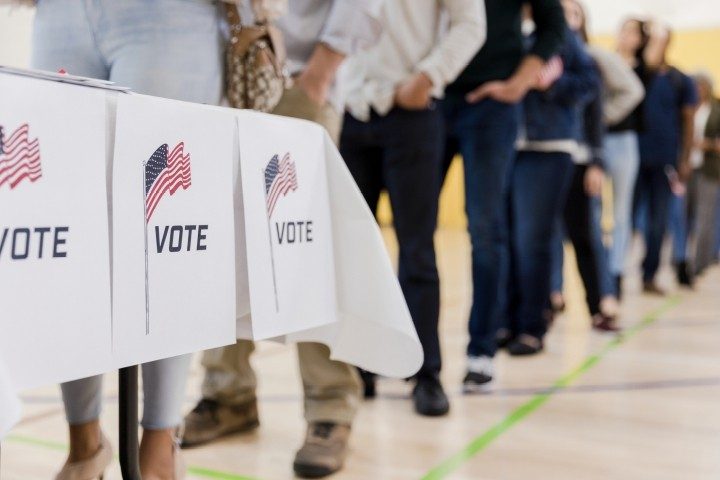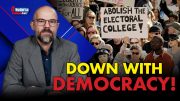
When voters are asked why they like early voting, most respond saying they want to avoid long lines on Election Day. But is early voting the proper solution to long lines, and if so, why are early voters enduring long lines during early voting?
The fact of the matter is that early voting as practiced in America opens up opportunities for election fraud.
Bottlenecks at Voter Check-in
The first bottleneck that slows down voters, and causes them to want early voting, is typically at voter check-in. The inefficient way to accomplish this is with all the voters in one line with only one or two election clerks checking them in and asking for their ID cards, etc. Sometimes this involves an electronic check using the voter’s ID card to be sure it has a match on centralized databases, such as the voter registration database, the state’s database of driver’s licenses, or other government-issued ID cards.
But is there a more efficient way to do voter check-in? The answer is yes, and an example of it can be seen in New Hampshire. This was documented in the October 22, 2018 issue of The New American:
The example to follow is that of New Hampshire, where there is no early voting. The New American interviewed New Hampshire Secretary of State William Gardner regarding efficiencies in the way his state runs elections. Secretary Gardner believes his state has the two largest voting locations in the United States. In the 2016 presidential election, the town of Londonderry had 12,794 voters who voted in person, and the town of Hudson had 12,457 voters vote in person. When asked why they didn’t have long lines at voter check-in, Secretary Gardner explained how efficient the voter check-in process is at these locations, where they have as many as 15 tables arranged alphabetically for voter check-in.
If the average American waiting in an inefficiently run voter check-in line knew there were viable options, some as simple as just merely having multiple check-in tables arranged alphabetically, to relieve the long, slow-moving lines, it is doubtful they would so readily accept something with the election integrity risks of early voting as a solution to the long lines they experience while waiting to vote.
Bottlenecks While Voters Are Voting
Another source of bottlenecks in voting, especially when there is a long and complicated ballot, occurs when voters tie up the voting booths for longer than the anticipated amount of time as they read through the choices and make their selections. While, at least in the experience of this writer, this bottleneck occurs considerably less frequently than the bottlenecks caused by inefficient voter check-in, it can nevertheless be a cause of long, slow-moving lines at polling places. New Hampshire’s efficiency is inherent in the voting equipment. One again from the October 22, 2018 issue of The New American:
It should be added that because of New Hampshire’s paper trail law, the only computerized voting equipment allowed is the optical scan type. With optical scan equipment the ballots are marked by the voters in the privacy of simple booths and then fed into the optical scan system, where the votes are tabulated immediately, tying up the piece of equipment for only a few seconds for each ballot cast. Contrast this with a computerized voting booth where the voter ties up a piece of equipment for the entire time he is reading the choices and making selections.
Another inherent efficiency of optical scan paper ballots is that it is relatively easy to add additional voting booths if the number of voters is higher than expected. Depending on the technologies used, some electronic voting booths have a limit to how many can be connected at one time and many times they must be connected to the check-in station so the voter can be given a one-time usage numeric code to activate the voting booth. Typically, this code is sent to all the connected voting booths, so the voter can vote at any available voting booth. But once the code is entered, it must be transmitted to all the other voting booths that the code has been used. This is done to prevent a voter from using that same code on multiple machines, thereby voting more than once using the same code. While this technology is impressive, the plain old paper ballot that is read by the optical scan equipment is equally good at preventing multiple voting because the voter can be handed one and only one ballot. And easier to coordinate and make scalable.
The liberal news media has given little or no publicity to the more efficient ways of processing voter check-in and voting booth efficiencies even though they are tested and proven in New Hampshire. Instead people are led to believe that early voting is the only known solution to long lines on Election Day.
Security Vulnerabilities in Early Voting
The list of election-integrity vulnerabilities that are increased by early voting include such things as repeat voting, temptations for behind-closed-doors access to the early ballots and, in some cases such as Texas, county-wide polling locations for early voting that negate some of the election-integrity features of the precinct.
Repeat Voting
Repeat voting, as the name implies, happens when a person votes more than once in an election. In the past, when elections have been investigated, that is one of the electoral fraud techniques that shows up on the list. The following quotations come from the report filed by the congressional investigation of the frauds in the 1868 general election in New York:
George Hill (P. 482) testifies that he was one of the gang of 16 or 20 repeaters on the day of the election, and he “voted nine or ten times in the different election districts of the city, mostly in the 8th ward.” The witness swears that he was very hard up, and had to steal, or do something to get a living.
The investigation into these repeaters also inquired into the character and motivations of the repeaters, and found that many were voters for hire because they were hard up for cash, something we might find today, at least in some case, if we had an investigation.
How effective were these voters-for-hire? Testimony from the investigation revealed:
In conversation with the chief men in this gang since the election, I have heard several of them boast that they had been registered and voted over 20 or 25 times, and some of them 30 times.
This was all done in an election that lasted only one day. One has to wonder how many times these repeaters could have voted if they had a few weeks of early voting?
Also, the previous quote from the congressional investigation showed that the repeat voting was tightly coupled with fraudulent voter registrations. Whether it be fraudulent or accidental, the United States has a horrible rate of voter over-registration. A recent study by Judicial Watch found 353 counties in the United States had more voter registrations than people eligible to vote. That same study also found at least eight states with 100-percent or higher voter-registration rates. These obviously incorrect voter registrations represent an opportunity for repeaters to cast multiple ballots, especially during early voting.
Another factor enabling repeat voting emanates from the weaknesses in the voter ID laws. Perhaps the single biggest loophole in voter ID is caused by elections no longer being conducted in public. At one time, American elections were completely public. Any member of the public was welcome to observe any and all aspects of an election except for the voters’ marking of the secret ballots. Now, in almost all states, the public is no longer allowed to just walk into a polling place or a central count and accumulation center. Instead, observers need to make preparations ahead of time, sometimes needing to meet onerous requirements to observe their own elections. Are the voters’ ID’s checked? Only the people inside know.
Access to the Early Vote Ballots and Vote Totals
The public is typically told that no one is allowed to have access to the early ballots or the vote totals, and most people accept that explanation without giving it a second thought. However, there are people who have authorized access to the early vote ballots. An example of this occurred on Saturday, October 31, 2020 when this writer was an appointed election observer at the central counting facility for Denton County, Texas. In order to be sure the write-in votes were processed in time, the ballot images were loaded into the computer at central count and only the write-in votes were examined and determined for whom each write-in was intended. There were four people present, a technician who was a county employee, a representative of the local Republican Party, a representative of the local Democratic Party, and this writer in his role as an appointed election observer. The process started on Saturday and was completed later. To the best of my knowledge, no ballot images other than the write-ins were examined. While that is a reassuring statement, the facts show that access was possible, and in places where the election officials are not as obedient to the law, who knows what happens? Do they resist temptation? Do they succumb to the temptation? It’s all behind closed doors.
Another example of what goes on behind closed doors during elections occurred a number of years ago when this writer was processing absentee ballots in a political primary election. A number of times the leader would say to all the people who processing the absentee ballots that the chairwoman of the political party wanted to know how certain contests were going. The other people on the board would sample about 10 of the cast ballots each and report the vote totals for each candidate and report each candidate’s sample percentage. This writer politely declined to participate.
In the case above, the anonymity of the ballots was preserved and no votes were altered. But that isn’t always so. Former Chicago Alderman James J. Laski, Jr., in his book My Fall from Grace — From City Hall to Prison Walls, recounted that some absentee ballots in Chicago would be opened, how the voter voted was noted, and the ballot altered if the voter didn’t vote right.
Another problem with having the ballots behind closed doors for weeks at a time is that the people with access are frequently Deep State government employees. The grand jury investigation of the 1908 Democratic Primary in Chicago identified many of the culprits to have been politically active people or government employees:
Almost universally we found the persons immediately responsible for many of said election frauds to be men holding elective offices and men holding responsible subordinate positions in the service of elected or appointed County Officials and of course paid by the taxpayers. Out of such facts grow the creation and continuance of offices serving no other purpose than to draw salaries from the taxpayers for assumed public services, but in fact being used to pay for venal services rendered to party bosses.
While it is a virtual certainty that the vast majority of government employees do not engage in electoral fraud, it takes only a few bad actors with behind-closed-doors access to accomplish evil. All the more reason to end early voting and behind-closed-doors processing and have all ballots cast in public on election day.
County-wide Voting — Destruction of the Precinct?
Some states, such as Texas, use county-wide polling locations during early voting. County-wide polling is sold to the voters as a convenience for them, as they can vote in any of a number of voting locations. But this convenience is also an additional reduction in the election integrity because it frequently blurs the precinct. The precinct has at least some of an effect on election intrepidity by having the voters cast their ballots in public on Election Day with their neighbors and other people watching to see who is voting. County-wide voting makes it difficult, if not impossible, to determine during a recount what went wrong. Do the people working at the polls obey the voter ID laws? Unless the polling locations are designated as public places with access to the public guaranteed, we’ll have no way to really be sure. Election fraud, when investigated, usually shows impressive organization and coordination. It is a virtual certainty that repeat voters during county-wide voting would communicate which voting locations are ignoring voter ID laws or doing other fraud-friendly actions. That would enable the repeaters to know which voting centers are fraud-friendly and should be the next stop on their list of places to vote.
If county-wide voting replaces the precinct now, what would be the next step? State-wide voting? What would happen if a fraud-friendly voting location welcomed fraudsters to stuff the ballot box for an election contest hundreds of miles away?
In conclusion, early voting is not necessary to cure the problem of long lines on Election Day. Efficient processing of elections on Election Day would do a better job, while not increasing risk of election-integrity problems.



